
| Manufacturer: | SaverLamp |
| Model: | "Super Spiral" 85W 2700K |
| Application: | General Lighting where high lighting levels are required or industrial lighting |
| Wattage: | 85W (65W measured) |
| Diameter (max): | 80mm |
| Length: | 260mm |
| Tube Length: | 1400mm approx |
| Bulb/Tube material: | Glass. Colour 827 phosphor coating on inner surface |
| Colour Temperature: | 2700K |
| Peak output wavelength: | N/A |
| Total light output: | 6'375Lm (Manufacturer's claim - 75Lm/W) |
| Rated lifetime: | 10'000 Hours |
| Cap: | B22 |
| Operating voltage: | 220-240V AC |
| Operating current: | 520mA |
| Warmup/restrike time: | 1 minute/none (Instant Start type ballast) |
| Cost (original): | £15.99 (Early 2004). |
| Place of manufacture: | Not Stated |
| Date of manufacture: | Q1 2004 |
| Lamp Status: | Working |
In recent years we have seen a definite trend for compact fluorescent lamps to shrink in size, having now reached the point where they actually CAN fit into fittings designed for incandescent lamps without sticking out the top. The last two table lamps in the sitting room here only today finally managed to ditch the 60W incandescent lamps in favour of 11W Philips Genie lamps. These two had been stuck for a while as they have very shallow shades, and only now had I managed to find lamps that small at a good price. However...not all CFLs are small...at the other end of the scale some manufacturers have been creating monsters...like this 85W beast. At not very far off a foot in length and roughly three and a half inches in diameter - this sucker is NOT going to fit in your average bedside table lamp...That however really is not what it was designed for.
This lamp is an interesting bit of engineering, very much showing the point at which companies had decided to start attempting to poach what had traditionally been roles filled by mercury or metal halide high intensity discharge lamps, which Megaman did manage to make a bit of an impact on around 2010 with their Clusterlite range before high power LED technology started to push fluorescent technology to one side. Probably a more sensible thing to consider this as than a replacement for 425W of incandescent lighting would be a replacement for a 250W mercury lamp, but with better colour rendering and no mains frequency flicker.
Technologically speaking, it's nothing hugely special - though the figures tend to make you think more of linear fluorescent lamps than compact ones. This similarity isn't really out of place either, with the tube itself being a relatively massive 1400mm (4.6 feet) in length. One of the interesting features about this particular lamp is that green ring you can see on the base This is actually addressing one of the main problems faced by most spiral type compact fluorescents. When these lamps are operated in a cap-up orientation, convection currents inside the spiral lead to a huge amount of heat being drawn up to the centre of the base, obviously with a lamp of this high a wattage, this problem would be especially prevalent. What that green ring is however, is a vented component which effectively provides "Thermal isolation" from the top cover of the base assembly itself. While the top surface of the base does get bombarded by these convection currents (as the yellowing of the plastic after nearly two years of use shows), the ballast compartment in the base can remain (relatively) cool. All I can say is that it seems to work! This lamp's been in daily use in the kitchen in this house since it was bought in February 2004, and it's still going strong.
You may recall that I said earlier that this thing probably wouldn't fit in your bedside light...this is probably a good thing. I for one, certainly would not want to have my eyes open if I switched this thing on in the middle of the night. The 10W PL-C in my bedside light's bad enough...but this thing....ouch! The output really is very, very impressive. I don't know whether I quite believe the manufacturer's claim of it being equivalent to 425W of incandescent light, but at the same time, it only appears to consume 65W of power rather than 85W...so all of the figures seem to be a little shaky. As I said, I'm not sure if their claims are right...but I can categorically say that it IS brighter than a 200W incandescent lamp, by quite a margin. The 150W one we used to use in the kitchen (and generally had to replace on a monthly basis) really seems like a candle in comparison. I
Obviously, it isn't a lamp for all uses. It's huge size preclude it from a lot of locations from the word go, as there are very few shades you're likely to see that it'll easily fit in. However, I can see that a couple of these would transform your previously dull and shadowy garage into a place where you can actually work after dark. Our kitchen was utterly transformed by the use of this lamp - leading us to actually abandon the previous plans to add linear fluorescent lamps under the cupboards. Which makes it suddenly seem an awful lot cheaper. Nearly £20 for a single compact fluorescent lamp initially sounds like a lot - but putting it in perspective like that, where at least four extra fixtures were going to be bought - it doesn't sound quite so bad any more.
My only real gripes with this lamp are that it uses an instant start ballast - in a lamp costing this much I'd really rather see a ballast which would pre-heat the lamp electrodes, as this can extend the lamp lifetime quite considerably, especially if it is switched frequently. The second one is really nit-picking; and that is that the plastic the case is made of is rather prone to yellowing as evidenced in the photographs below. This really is not an issue, and does not affect the operation of the lamp in the slightest - but it makes it look a bit of a mess.
I have heard rumours that a 125W version of this lamp also exists, though I have never actually seen one. If you know somewhere where these are sold, or have ever seen one, please let me know. Will certainly be adding one to the collection if I see it.

SaverLamp 85W 2700K Compact Fluorescent Lamp - General overview
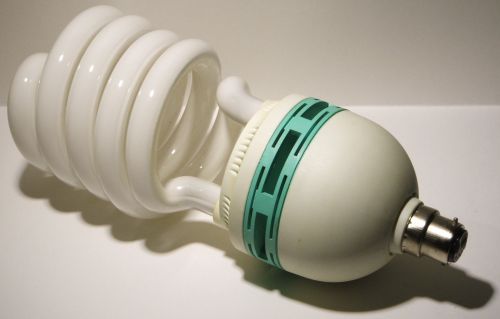
SaverLamp 85W 2700K Compact Fluorescent Lamp - Detail of lamp cap - note how tiny the B22 cap looks compared to the lamp!
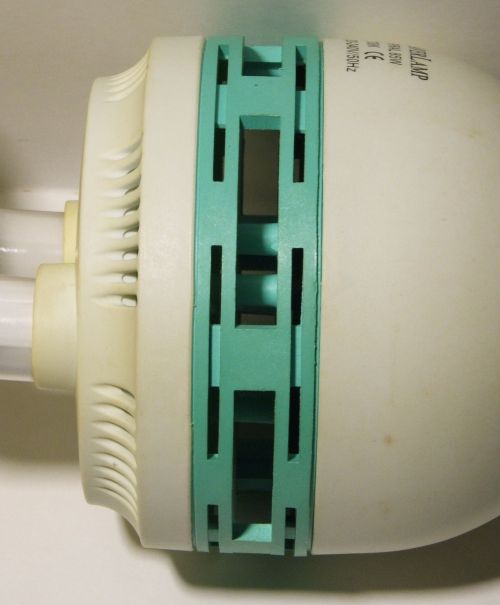
SaverLamp 85W 2700K Compact Fluorescent Lamp - Detail of thermal isolation gap in lamp base
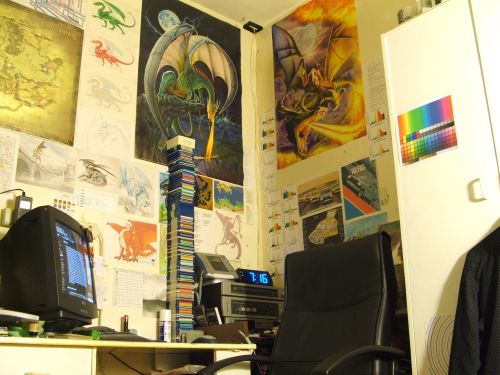
SaverLamp 85W 2700K Compact Fluorescent Lamp illuminating my workstation from a distance of approximately two metres
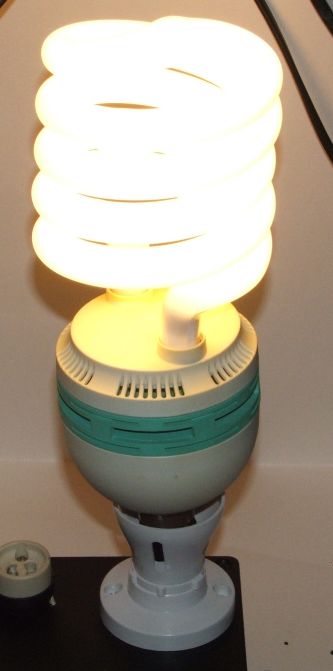
SaverLamp 85W 2700K Compact Fluorescent Lamp - Overview of lamp shown while lit
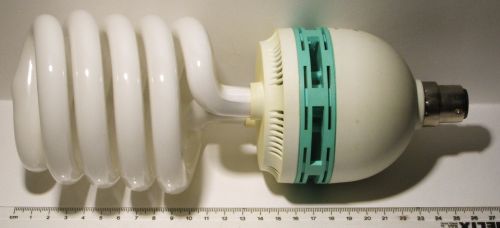
SaverLamp 85W 2700K Compact Fluorescent Lamp shown with a ruler to show length of the lamp
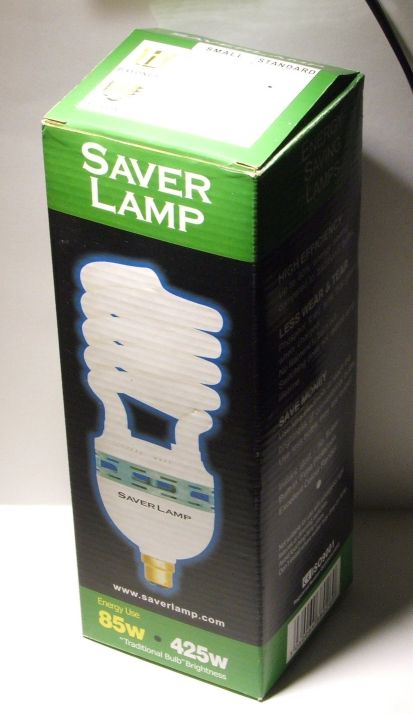
SaverLamp 85W 2700K Compact Fluorescent Lamp - Overview of lamp packaging

SaverLamp 85W 2700K Compact Fluorescent Lamp Output Spectra
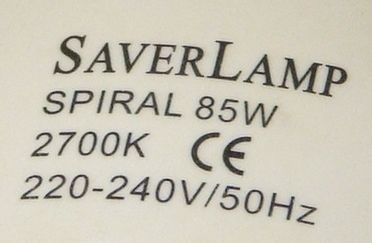
SaverLamp 85W 2700K Compact Fluorescent Lamp - Detail of text printed on lamp base

This lamp added to the Virtual Display Shelf on the 12th February 2006 at 20:03.
References: None.
Acknowledgements: None.
This page was last updated on:
16th June 2023: Made changes to the page formatting to improve readability on mobile devices. Some background page code changes have also been made to improve search engine behaviour.